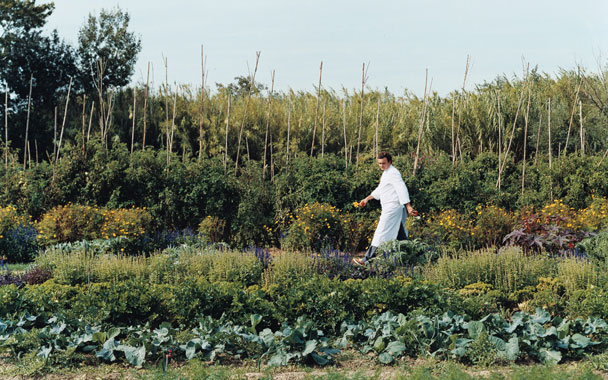My wife and I sat down to lunch one day about 20 years ago at Chez Paul, a small, old-fashioned bistro on the Île-de-la-Cité, in Paris. She’d had about enough, by that time, of all the duck liver and pork fat and cream sauces we’d been consuming for six days straight, so while I soldiered on with the pâté maison and blanquette de veau, she ordered a simple green salad to begin and, for her main course, asked the snappish, timeworn waitress if she could just have “le légume du jour,” the menu’s unspecified vegetable of the day. “Le légume du jour?” the woman asked, incredulously. “,” replied my wife. The waitress shrugged. Out came my pâté and her salad; so far, so good. Then my blanquette de veau was served, and for my wife…a plate of french fries. “Voilà le légume du jour,” announced the waitress, more than a little triumphantly.
A lot has changed in 20 years. Though Chez Paul itself hangs on, bistros like it—once commonplace in Paris—have almost disappeared, and, er, I have an entirely different wife. But what has not changed is the paucity of légumes, other than potatoes, on most French menus, especially traditional ones. There are admittedly certain classic protein-and-vegetable combinations (pigeon with peas, lamb with flageolets, the savory stew called boeuf aux carottes), and some menus do offer simply cooked spinach or green beans as a “garniture” or asparagus as a separate course. There are also at least a few contemporary French chefs who pay special attention to vegetables, most notably the immensely creative Alain Passard at his L’Arpège, in Paris. But as another chef, Jean-Luc Rabanel, puts it, “In general, people in France don’t consider vegetables a food. They’re just something on the side.”
In a different way from Passard, and almost 500 miles to the south, Rabanel and a few other French chefs are doing their best to help change that situation.
La Chassagnette is an all-organic restaurant on a 500-acre farm of the same name, opened in 2000 by Swiss pharmaceuticals heiress Maja Hoffmann (as in Hoffmann-La Roche) and her husband, the American film producer Stanley Buchthal. It’s in the Camargue, one of the most fascinating and romantic parts of France, a vast, marshy river delta defined by the Rhône as it extends down from Arles and then forks, like a wavy wishbone, into two arms flowing to the sea. This extra-ordinary region is famous for its wild white horses, its hot-pink flamingos, and its fighting bulls (raised for the bloodless corridas popular in the region), as well as for its production of rice and sea salt. It is also the home of La Tour du Valat, an important center for the study and conservation of Mediterranean wetlands, founded in 1954 by Maja’s father, Luc Hoffmann, who was a naturalist (he later became vice president of the World Wildlife Fund) as well as a pharmaceuticals magnate.
Maja Hoffmann went to school in Arles and spent much of her childhood in the Camargue, and she inherited her father’s respect for the region’s unique ecosystem. She also became a champion of organic and biodynamic farming, and it was her idea to develop La Chassagnette into a kind of inspirational complex that would include a gastronomic library and study center, a farm supplying fruit and vegetables to local markets, and a restaurant to showcase all that the farm produced.
At first, the kitchen at La Chassagnette was run by Edith and Manu Camacho, proprietors of a popular seafood restaurant called Chez Juju, in nearby Salin-de-Giraud. By the time I first visited, three years ago, the Camachos had returned to Chez Juju, and Rabanel, a widely traveled Gascon-born chef, had taken over, promptly winning La Chassagnette a Michelin star. (It was the first all-organic restaurant in France—and so far the only one—to be given that honor.) I had a wonderful, unusual dinner there, a succession of dishes that seemed alternately rustic (beets baked in a crust of salt; baby cuttlefish roasted with garlic, thyme, and Espelette peppers) and modishly contemporary (gazpacho topped with emulsified tomato water; a flaky pastry stuffed with cumin-scented puréed yellow squash, meant to be dipped into cèpe cream and crushed pine nuts). There was something pleasingly eccentric about the whole affair, and something refreshingly original; it was the kind of food, I remember thinking, that might have resulted if Alice Waters had sat Ferran Adrià down and talked some sense into him.
In the fall of 2005, Rabanel decided to leave La Chassagnette. There were—metaphorically—too many cooks. “I was absolutely persuaded of the possibility to make Chassagnette into a three-star restaurant,” he says. “Unfortunately, the farm had a number of directors and there was also the family of the proprietor to consider, and everyone had his point of view. I decided that I wanted to do something on a smaller scale, something more precise.” Following his departure, the restaurant lost its Michelin star.
And a new star was born. Rabanel’s precise new venue is L’Atelier de Jean-Luc Rabanel, an austere “workshop” restaurant that opened on a side street in Arles early in 2006. He no longer has the agricultural riches of La Chassagnette to draw from, but Rabanel—who grew up on a farm in the village of Monflanquin, just northwest of Cahors—now has a certified-biodynamic farm of his own on the outskirts of the city, which yields a lot of what he uses.



 Pinterest
Pinterest






